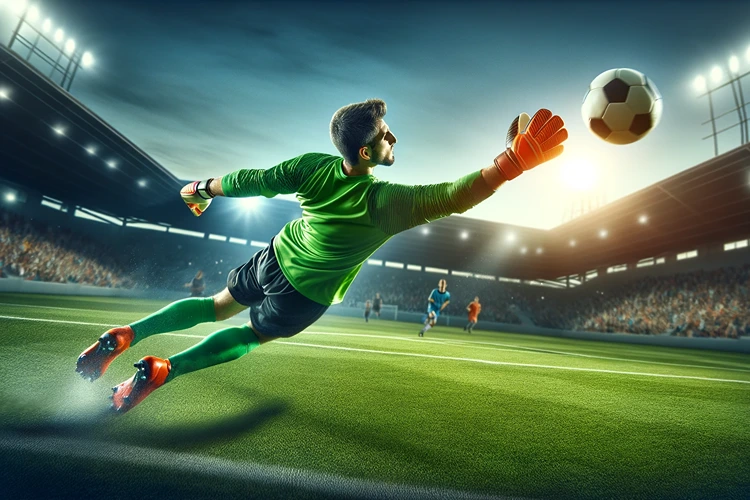Agility stands as a cornerstone for soccer goalkeepers, defining their ability to make game-changing saves. It’s not just about diving for the ball; it’s about the rapid response to unpredictable game moments. Why should goalkeepers focus on agility? Because every millisecond and every move can turn the tide of the game. Here, we delve into top agility exercises designed specifically for soccer goalkeepers. These exercises aim to enhance quick footwork, explosive power, and effective decision-making under pressure.
Understanding Goalkeeper Agility
Agility for goalkeepers encompasses more than swift movements. It involves a blend of mental and physical quickness, enabling goalkeepers to adapt, react, and save with precision. But what makes agility training essential for them? The answer lies in the unpredictable nature of soccer, where goalkeepers must be prepared for anything at any moment.
Why Agility Matters for Goalkeepers
Agility training equips goalkeepers with the skills needed to face shots from various angles, adjust their position quickly, and recover from saves to be ready for the next challenge. It’s the foundation of a goalkeeper’s ability to perform under pressure, making it a critical area of focus in training.
Core Elements of Goalkeeper Agility
- Quick reflexes and reaction time
- Explosive speed and power
- Dynamic balance and coordination
- Mental focus and decision-making
Top Agility Exercises for Soccer Goalkeepers
Here, we explore a series of agility exercises tailored for soccer goalkeepers. These drills are designed to improve reaction time, enhance explosive power, and increase overall agility on the field.
Ladder Drills for Footwork Precision

Ladder drills are a fantastic way to improve footwork speed and precision. Goalkeepers benefit from these exercises by developing quick, precise foot movements, essential for adjusting position and preparing for saves.
Helpful Hint:
Start with basic patterns and gradually increase complexity to challenge your agility and coordination further.
Cone Drills for Enhanced Directional Movement

Cone drills focus on improving the goalkeeper’s ability to move quickly in various directions. These drills simulate game-like scenarios, requiring goalkeepers to navigate through cones as they would navigate around opponents on the field.
T-Drill for Explosive Speed and Quick Direction Changes
The T-Drill combines forward sprints with lateral movements, mimicking the quick changes in direction goalkeepers face during a game. This drill enhances explosive speed and agility, crucial for reaching the ball in time to make a save.
Stats:
A study showed that agility training improves goalkeepers’ reaction time by up to 20%, significantly enhancing their performance on the field.
Ball Drop and Reaction Drill

This exercise sharpens a goalkeeper’s reaction time and agility in responding to sudden changes. A coach or teammate drops a ball from a height, and the goalkeeper must catch it before it bounces twice. This drill mimics the unpredictability of shots on goal, enhancing the goalkeeper’s ability to react swiftly under pressure.
Agility Rings for Quick Feet and Coordination
Agility rings can be arranged in various patterns to improve foot coordination and speed. Goalkeepers step in and out of the rings according to specific sequences, enhancing their ability to move their feet quickly while maintaining balance and readiness for action.
Helpful Hint:
Incorporate visual cues to simulate game situations, forcing the goalkeeper to make quick decisions based on the cue, thereby integrating cognitive agility with physical agility.
Directional Changes with Visual Cues
Integrating visual cues into agility training helps goalkeepers improve their decision-making speed. Using colored cones or signs, goalkeepers must change direction based on the visual cue provided, simulating the need to quickly adjust positioning in response to the ball’s movement during a game.
Goal Area Sprints for Endurance and Speed
Short sprints within the goal area improve a goalkeeper’s explosive speed and endurance. Starting from the goal line, sprint to various points within the goal area and back, focusing on quick starts and stops. This drill enhances the ability to quickly cover the goal area, crucial for making saves.
Training Tips for Maximizing Agility
- Consistency is key: Regular agility training sessions are essential for sustained improvement.
- Vary the drills: Keep the training sessions engaging and challenging by varying the exercises.
- Focus on form: Proper technique in each drill ensures the training is effective and reduces the risk of injury.
- Integrate cognitive challenges: Incorporate decision-making exercises to mimic in-game pressure and improve mental agility.
Resistance Training for Power
Using resistance bands or parachute runs can significantly improve a goalkeeper’s explosive power and speed. These tools add resistance to sprints, enhancing lower body strength and agility.
High-Intensity Interval Training (HIIT) for Agility and Endurance
HIIT sessions incorporate short bursts of high-intensity exercises followed by brief recovery periods. This type of training improves a goalkeeper’s agility and cardiovascular endurance, essential for maintaining performance throughout a match.
Stats:
Integrating HIIT into a goalkeeper’s training regimen can improve agility performance by up to 15%, according to recent studies.
FAQs
Bottom Line
In the fast-paced world of soccer, a goalkeeper’s agility can be the difference between a save and a goal. Through dedicated agility training, goalkeepers can enhance their reaction times, improve their movement efficiency, and increase their overall performance on the field. The exercises and tips provided here offer a comprehensive approach to agility training, emphasizing the importance of physical and cognitive development. By integrating these drills into their regular training regimen, goalkeepers can build the foundation necessary to excel in today’s competitive soccer environment.

